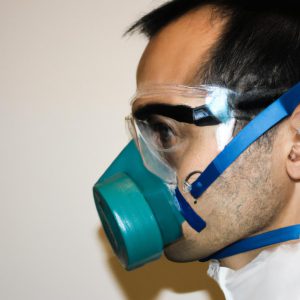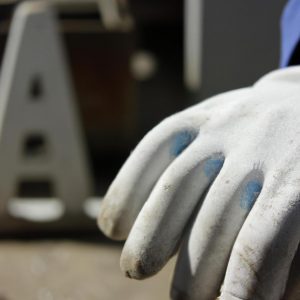First Aid Kits for Industrial Goods and Services: Essential Safety Equipment

First aid kits are an essential component of safety measures in various industries that deal with the production, handling, and provision of goods and services. These kits serve as a first line of defense against injuries and emergencies, providing immediate medical assistance until professional help arrives. For instance, consider a hypothetical scenario where a worker in a manufacturing plant sustains a deep cut while operating heavy machinery. In such cases, having a well-equipped first aid kit readily available can potentially save lives and prevent further complications.
Industrial settings present unique challenges when it comes to ensuring workplace safety. The nature of industrial goods and services often involves hazardous materials, high-risk activities, and potential accidents. Consequently, employers must prioritize the implementation of effective safety protocols alongside providing adequate training and resources for their employees. Among these crucial resources is the presence of comprehensive first aid kits specifically tailored to address the risks associated with industrial work environments. This article aims to explore the importance of first aid kits within industrial contexts, highlighting their significance as essential safety equipment for protecting both workers’ well-being and organizational productivity.
Understanding the Importance of First Aid Kits in Industrial Environments
Picture this scenario: A worker in a manufacturing plant accidentally cuts his hand while operating heavy machinery. Blood begins to flow, and panic ensues as nearby coworkers scramble to find something that can help stop the bleeding. Unfortunately, there is no first aid kit readily available, leaving everyone feeling helpless and uncertain about what steps to take next. This situation highlights the critical importance of having well-stocked and easily accessible first aid kits in industrial environments.
In an industrial setting, accidents and injuries are not uncommon occurrences. The nature of work in industries such as construction, manufacturing, or mining often involves high-risk activities that pose significant dangers to workers’ health and safety. Without proper precautions in place, these incidents can lead to severe consequences ranging from minor cuts and bruises to more serious injuries or even fatalities.
Having a comprehensive first aid kit readily available serves as an essential line of defense when it comes to mitigating the impact of workplace accidents. These kits are meticulously designed with specific equipment and supplies tailored for addressing various types of injuries commonly encountered in industrial settings. By providing immediate access to items such as bandages, sterile dressings, antiseptics, splints, eyewash solutions, thermal blankets, and CPR masks, first aid kits enable prompt medical intervention before professional help arrives.
To emphasize the significance further, consider the following bullet points:
- First aid kits significantly reduce response time during emergencies.
- They facilitate timely treatment that can prevent complications or deterioration of injury conditions.
- Properly stocked kits contribute to compliance with occupational health and safety regulations.
- Accessible first aid supplies promote a culture of safety consciousness among employees.
Additionally, here’s a table showcasing some typical contents found in a well-equipped industrial first aid kit:
| Item | Purpose | Quantity |
|---|---|---|
| Band-Aids | Small cuts or abrasions | 50 |
| Sterile Gauze Pads | Wound dressing | 10 |
| Adhesive Tape | Securing dressings or splints | 2 rolls |
| Antiseptic Solution | Cleaning wounds and preventing infection | 1 bottle |
| Disposable Gloves | Protection against contamination during first aid | 20 pairs |
| CPR Mask | Assisting with rescue breathing | 1 |
| Instant Cold Packs | Reducing swelling or pain caused by sprains or strains | 4 packs |
In conclusion, the presence of well-stocked and easily accessible first aid kits is essential in industrial environments to ensure prompt medical intervention during emergencies. These kits not only provide immediate access to necessary supplies but also contribute to a culture of safety consciousness among employees. In the following section, we will delve into determining the appropriate first aid kit for your specific industry needs, guiding you through the process of selecting the most suitable equipment.
[Next Section: Determining the Appropriate First Aid Kit for Your Industry]
Determining the Appropriate First Aid Kit for Your Industry
In a bustling factory setting, accidents and injuries can occur unexpectedly. Without proper first aid measures in place, workers may face delays in receiving immediate medical attention, exacerbating their condition and potentially leading to long-term consequences. To emphasize the significance of having well-equipped first aid kits in industrial environments, let us consider a hypothetical scenario.
Imagine a manufacturing facility where heavy machinery is operated daily by skilled workers. One day, an employee accidentally cuts his hand while operating a piece of equipment. In this moment of distress, having a readily accessible first aid kit nearby could make all the difference. With essential supplies such as bandages, antiseptic wipes, and gloves available within arm’s reach, the injured worker receives prompt treatment that prevents infection and minimizes further damage.
To better understand what constitutes an effective industrial first aid kit for various industries, it is helpful to consider several key factors:
- Industry-specific risks: Different sectors present distinct hazards that need to be addressed appropriately. For instance, construction sites may require additional supplies like splints or tourniquets due to the high risk of falls or crushing injuries.
- Size and layout of workplaces: The size and layout of industrial spaces play a crucial role in determining how many first aid kits are needed and where they should be strategically placed for easy accessibility.
- Number of employees: A larger workforce translates into higher chances of accidents occurring simultaneously. Consequently, multiple adequately stocked first aid kits are necessary to cater to these situations efficiently.
- Regulatory requirements: Compliance with relevant workplace health and safety regulations is imperative. Employers must ensure that their first aid kits meet legal standards specific to their industry.
Table 1 below summarizes some common types of industries along with potential risks associated with each sector:
| Industry | Potential Risks |
|---|---|
| Manufacturing | Cuts from machinery |
| Construction | Falls from heights, head injuries |
| Mining | Respiratory issues, chemical exposures |
| Transport | Traffic accidents, physical strains |
By recognizing the specific risks and needs of their industry, employers can make informed decisions regarding the appropriate first aid kits to have on hand. In doing so, they demonstrate a commitment to prioritizing employee safety while ensuring compliance with legal requirements.
Transitioning into the subsequent section about “Essential Contents of an Industrial First Aid Kit,” it is crucial to examine what makes up a comprehensive kit that caters specifically to industrial environments. By considering the unique challenges faced in these settings, we can ensure that workers are well-equipped to handle any medical emergencies that may arise.
Essential Contents of an Industrial First Aid Kit
Determining the Appropriate First Aid Kit for Your Industry is crucial to ensure that you have the necessary supplies to address potential injuries or medical emergencies in your workplace. In this section, we will explore the essential contents of an industrial first aid kit and highlight their significance.
Consider a hypothetical scenario where an employee working in a manufacturing facility sustains a deep laceration on their arm while operating machinery. Without proper first aid equipment readily available, precious time may be lost searching for appropriate supplies, potentially worsening the injury. To avoid such situations, it is imperative to carefully evaluate the specific needs of your industry when selecting a first aid kit.
When assessing the requirements for your industrial setting, keep in mind these key factors:
- Nature of work: Identify the unique risks associated with your industry. For example, construction sites may require specialized items like cold packs or eye wash solutions for incidents involving chemicals or foreign objects.
- Size of workforce: Consider the number of employees who could potentially need immediate medical attention simultaneously. This will determine how many kits are needed and what quantity of each item should be stocked.
- Proximity to medical facilities: Evaluate the accessibility and distance to nearby healthcare providers. The availability of emergency services can influence the level and extent of supplies required in your first aid kit.
- Regulatory compliance: Familiarize yourself with local regulations and guidelines set forth by relevant authorities regarding occupational health and safety standards specific to your industry.
- Immediate access to essential medical supplies can save lives during critical moments.
- Well-prepared workplaces demonstrate a commitment to employee safety and well-being.
- Having adequate first aid resources instills confidence among workers that they are protected even in hazardous situations.
- Being prepared not only safeguards employees but also mitigates legal liabilities for employers.
Additionally, let’s include a table showcasing the essential contents commonly found in industrial first aid kits:
| Item | Quantity | Purpose |
|---|---|---|
| Adhesive bandages | 20 | Cover minor cuts and abrasions |
| Sterile gauze pads | 10 | Control bleeding and dress wounds |
| Antiseptic wipes | 10 | Cleanse injured areas to prevent infection |
| Disposable gloves | 5 pairs | Protect against cross-contamination |
In conclusion, selecting an appropriate first aid kit for your industry is a critical step in ensuring workplace safety. By considering factors such as the nature of work, size of the workforce, proximity to medical facilities, and regulatory compliance, you can tailor your kit to address specific risks. Remember that having well-stocked first aid supplies not only meets legal obligations but also plays a significant role in fostering a safe working environment.
Transitioning into the subsequent section on “Proper Storage and Maintenance of First Aid Kits,” it is vital to understand how these indispensable resources should be handled to ensure their effectiveness during emergencies.
Proper Storage and Maintenance of First Aid Kits
In a real-world scenario, imagine a worker in an industrial setting suffering from a laceration caused by sharp machinery. Without immediate medical attention, this injury can quickly escalate into a more severe condition. This emphasizes the importance of having well-equipped first aid kits readily available in industrial environments. To ensure efficient treatment and minimize potential risks, it is crucial to understand the essential contents of an industrial first aid kit.
Firstly, every industrial first aid kit should include basic items such as adhesive bandages, sterile gauze pads, and antiseptic wipes. These components are essential for cleaning wounds and providing initial protection against infection. Additionally, including adhesive tape ensures that dressings remain securely in place during transportation or movement within the workplace.
Secondly, considering the nature of potential injuries in an industrial environment, it is vital to have specialized equipment included in the first aid kit. For instance, eye wash stations with saline solution bottles must be easily accessible near areas where hazardous chemicals are handled. In situations involving burns or exposure to corrosive substances, burn gel packets and chemical cold packs play a significant role in alleviating pain and reducing further damage.
Thirdly, specific tools like splints and instant ice packs can assist in immobilizing fractures and reducing swelling respectively until professional medical help arrives. The inclusion of these items demonstrates proactive measures taken by organizations to provide prompt care while awaiting emergency services.
Lastly, it is imperative for employers to consider any industry-specific risks when selecting additional supplies for their first aid kits. Specialized industries may require equipment such as snake bite kits or oxygen masks based on the unique hazards associated with their operations.
To illustrate the significance of proper first aid preparedness in different industries, let us consider four distinct scenarios:
- A construction site where falls from heights pose substantial risks.
- A manufacturing facility dealing with heavy machinery that presents crushing hazards.
- An oil refinery exposed to potential chemical spills and fires.
- A warehouse with a high volume of manual material handling, increasing the likelihood of musculoskeletal injuries.
| Industry | First Aid Kit Additions |
|---|---|
| Construction | Fall arrest harnesses |
| Manufacturing | Finger splints |
| Oil Refinery | Chemical-resistant gloves |
| Warehouse | Back braces |
These examples emphasize that customizing first aid kits based on industry-specific risks is crucial to ensure optimal safety in the workplace. By incorporating these necessary contents into industrial first aid kits, employers can effectively address immediate medical needs before professional help arrives.
Transitioning smoothly to the subsequent section about “Training and Certification for First Aid Kit Users,” it becomes apparent that having well-stocked first aid kits alone is insufficient. To maximize their effectiveness, it is essential for individuals within an organization to possess adequate knowledge and training on how to use these vital resources efficiently.
Training and Certification for First Aid Kit Users
As we have discussed the proper storage and maintenance of first aid kits, it is equally important to ensure that individuals responsible for using these kits are trained and certified in their usage. This section will delve into the significance of training and certification for first aid kit users.
Proper training equips individuals with the necessary knowledge and skills to effectively respond during emergency situations. Take, for example, a hypothetical scenario where an employee sustains a deep laceration while operating machinery in an industrial setting. Without appropriate training, fellow workers may panic or administer incorrect treatment, leading to further complications. However, if employees undergo comprehensive first aid training, they would be equipped with the skills to assess the situation accurately and provide immediate assistance until professional medical help arrives.
- Increased confidence in handling emergencies.
- Enhanced ability to save lives and minimize injuries.
- Improved workplace safety culture.
- Peace of mind knowing that there are capable individuals who can provide prompt medical care when needed.
Now let’s look at a three-column table showcasing some key benefits of training and certification:
| Benefits | Description | Emotional Response |
|---|---|---|
| Skill development | Acquiring essential life-saving techniques | Empowerment |
| Team collaboration | Fostering cooperation among colleagues | Unity |
| Effective response | Swift action during critical incidents | Security |
In conclusion, providing adequate training and certification opportunities for first aid kit users plays a vital role in ensuring effective emergency response within industrial settings. By imparting crucial knowledge and fostering practical skills, organizations can create an environment where employees feel confident in handling unforeseen medical situations. The subsequent section will discuss the regular auditing and upgrading of first aid kits as another integral aspect of maintaining workplace safety standards.
Moving on from considering proper training and certification, let us now explore the importance of regular auditing and upgrading of first aid kits.
Regular Auditing and Upgrading of First Aid Kits
Having discussed the importance of training and certification for first aid kit users, it is now vital to emphasize the need for regular auditing and upgrading of these kits. By ensuring that first aid kits are regularly checked, maintained, and updated, companies can guarantee their employees have access to well-equipped kits in case of emergencies.
To illustrate the significance of this practice, let us consider a hypothetical scenario at an industrial facility where a worker sustains a deep laceration while operating machinery. Without immediate access to proper medical supplies within the first aid kit, such as sterile bandages or antiseptic solutions, the severity of the injury could escalate rapidly. However, through diligent regular audits and upgrades, potential risks like these can be mitigated effectively.
Regular audits play a crucial role in maintaining comprehensive first aid kits. These evaluations ensure that all items are present, intact, unexpired, and easily accessible when needed. Moreover, they allow organizations to identify any deficiencies or gaps in their existing inventory promptly. Through periodic inspections conducted by trained professionals, companies can address issues such as missing supplies or expired medications efficiently.
Upgrading first aid kits should not be limited solely to restocking necessary items; it should also encompass advancements in safety technology. Staying informed about new developments enables organizations to enhance their emergency response capabilities continually. For instance:
- Incorporating innovative wound closure methods like adhesive strips or liquid stitches into first aid kits.
- Including compact cardiopulmonary resuscitation (CPR) devices with step-by-step voice instructions.
- Equipping kits with specialized burn dressings designed specifically for industrial environments.
- Providing easy-to-use tourniquets to control severe bleeding in emergency situations.
| Benefits | Considerations | Implications |
|---|---|---|
| Ensures preparedness | Identifies deficiencies | Mitigates risks effectively |
| Keeps supplies fresh | Promotes continuous improvement | Enhances emergency response |
| Addresses gaps promptly | Incorporates new safety technology | Facilitates efficient treatment |
By prioritizing regular audits and upgrades, companies demonstrate a commitment to the well-being of their employees. This proactive approach ensures that first aid kits are always up-to-date and adequately stocked, maximizing the potential for effective medical intervention during emergencies. Establishing rigorous auditing protocols and embracing technological advancements further enhances workplace safety, fostering an environment where employees can feel secure knowing they have access to reliable medical resources when needed.
Therefore, it is imperative for organizations to recognize the significance of regularly auditing and upgrading their first aid kits as part of their broader safety management strategies. Through ongoing assessments and improvements, businesses can safeguard against potential hazards, thereby preserving both the physical health and overall well-being of their workforce.



